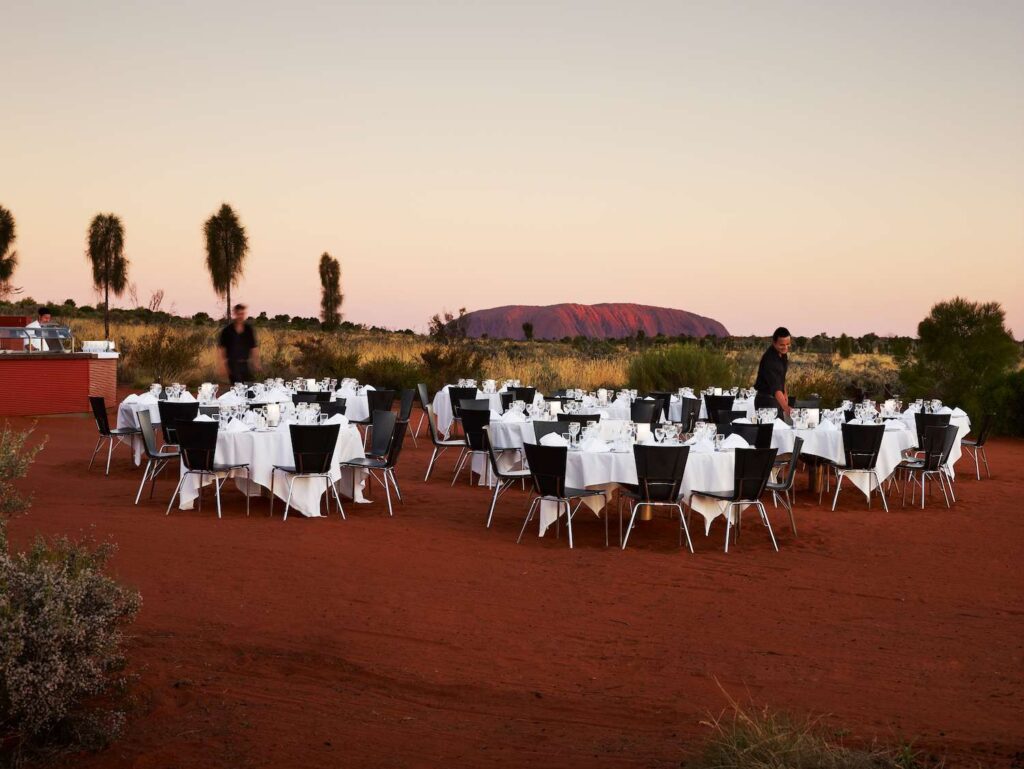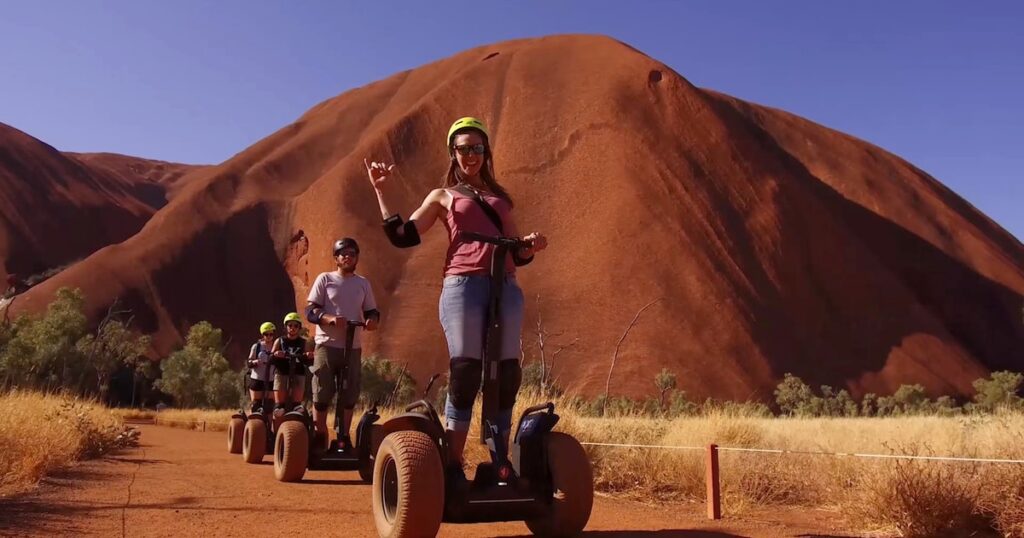Uluru Travel Guide – Uluru, also called Ayers Rock, rises proudly from the vast desert of Australia’s Red Centre. It is one of the most famous natural landmarks in the world.
This huge sandstone rock is not only a geological wonder but also a sacred site for the Anangu people, the traditional Aboriginal owners of the land.
In addition, Uluru is a UNESCO World Heritage Site known for its natural beauty and cultural importance. Every visitor feels a deep and spiritual connection to this land. Overall, Uluru captures the true heart and spirit of Australia’s Northern Territory.

Where Is Uluru Located?: Uluru travel guide
Uluru is located in the Uluru–Kata Tjuta National Park in Australia’s Northern Territory. It sits about 450 kilometres southwest of Alice Springs, right in the heart of the country.
This massive sandstone rock is part of Australia’s Red Centre, a region famous for its red deserts, ancient rock formations, and Aboriginal culture. Today, Uluru stands as a powerful symbol of both natural beauty and spiritual heritage. Because of its timeless charm, it continues to draw travellers from all over the world who come to admire its beauty and meaning.
Highlights of Visiting Uluru: Uluru travel guide
1. Sunrise & Sunset Views
Uluru changes colour beautifully as the sunlight moves across the sky. At sunrise, the rock glows in soft purple and orange tones, creating a calm and magical scene.
Later in the day, the colours change again. As the sun sets, Uluru shines with bright reds and golden light that fill the desert with warmth.
Visitors can rest at special viewing platforms that offer the best spots for photos. In addition, many sunrise tours include breakfast in the desert, turning the morning into a truly relaxing and memorable experience.
2. Uluru Base Walk
The Uluru Base Walk is a 10.6-kilometer trail that circles the entire base of this sacred rock. Along the way, you’ll see caves, waterholes, and ancient rock art that tell stories of Uluru’s long history.
If you prefer, you can join a guided tour to hear tales from the Tjukurpa, the Anangu people’s traditional stories of creation. Through these stories, visitors build a closer connection with the land and its deep spiritual meaning.
In the end, the walk combines nature, history, and culture into one unforgettable experience under the vast desert sky
3. Cultural Experiences with the Anangu
Beyond the region’s natural beauty, travellers can also enjoy authentic cultural experiences with the Anangu people. You can paint with local artists, taste traditional bush foods, or join storytelling walks that share ancient wisdom in a warm and friendly way.
Through these hands-on moments, visitors learn how the Anangu have cared for the land for thousands of years. Because of this deep bond, every traveller leaves with a true respect for Indigenous culture and traditions. In the end, it’s an experience that connects nature, history, and people in a meaningful way.

Why You Can’t Climb Uluru Anymore: Uluru travel guide
Climbing Uluru has been banned since October 2019 because the site is sacred to the Anangu people. Today, visitors are encouraged to connect with the land in respectful and meaningful ways.
For instance, you can listen to local stories, join guided walks, or capture the beauty of the red desert through your camera lens. By doing so, travellers can feel the spirit of Uluru while honouring its deep cultural value.
Where to Stay Near Uluru: Uluru travel guide
Most travellers stay in Yulara, also known as Ayers Rock Resort. This small desert village is the main gateway to Uluru. It offers a wide range of stays, from luxury lodges like Sails in the Desert to eco-friendly glamping tents and budget campgrounds.
Around the resort, you’ll find shops, cafés, restaurants, art galleries, and cultural centres. Together, these places create a lively and welcoming base for anyone who wants to explore Uluru and the beautiful desert landscapes nearby.
Best Time to Visit Uluru
The best time to visit Uluru is from May to September, when the weather is cool and pleasant. During these months, the days are comfortable for exploring, and the nights are clear and calm. It’s the perfect season for stargazing under the bright desert sky.
In contrast, the summer season runs from December to February, and it can get extremely hot. Temperatures often rise above 40°C (104°F), making sightseeing tiring and uncomfortable. Because of this, it’s best to plan outdoor activities early in the morning or later in the evening. This helps you stay cool, safe, and enjoy your visit without the harsh midday heat.

Photo Spots for Your Blog or Instagram
1. Talinguru Nyakunytjaku Viewing Area – Perfect for Sunrise
Start your day at the Talinguru Nyakunytjaku Viewing Area and watch the sunrise over Uluru. As the first light touches the desert, the land glows with warm reds and golds. The whole scene comes alive with colour and calm energy.
You’ll feel inspired by the peaceful beauty that surrounds you. It’s truly the best way to begin your morning adventure in the Outback.
2. Kuniya Walk – Leading to Mutitjulu Waterhole
After sunrise, take the Kuniya Walk, a short and easy trail that leads to the Mutitjulu Waterhole. Along the way, you’ll see ancient rock art and sacred Aboriginal sites that share stories from centuries past.
Because the path is gentle and shaded, it’s perfect for visitors of all ages. It also offers a close-up view of Uluru’s cultural side and the Anangu people’s traditions. Each step, therefore, connects you to the land’s deep history and peaceful spirit.
The trail feels quiet, calm, and meaningful. Surrounded by nature and heritage, you’ll sense why this place holds such a special place in Aboriginal culture.
3. Uluru Sunset Viewing Carpark – For a Panoramic Sunset Shot
In the evening, head to the Uluru Sunset Viewing Carpark for a truly stunning view. As the sun sinks below the horizon, Uluru changes colour, glowing from deep orange to rich red. Photographers and travellers alike love this spot because it offers wide, open views of both the desert and the sky. It’s a peaceful and magical way to end your day at Uluru.
4. Field of Light – A Night of Wonder
After sunset, visit the Field of Light, a breathtaking art installation that fills the desert with more than 50,000 solar lights. As night falls, the landscape transforms into a sea of glowing colours that seem to dance across the sand.
This incredible artwork, created by artist Bruce Munro, beautifully blends art, nature, and light. Together, they create a peaceful and unforgettable scene that stays in your heart long after you leave.
Travel Tips: Uluru travel guide
Start your journey by flying directly to Ayers Rock Airport (Connellan Airport). It’s the quickest and easiest way to reach this beautiful part of Australia. Before you go, remember to pack plenty of water, sunscreen, and a hat. The desert sun is strong, and shade is limited, so protecting yourself is essential.
While exploring, always respect the local culture and follow the signs. The Anangu people, who care for this land, consider some areas sacred. Because of this, visitors are kindly asked not to take photos in certain places.
To make the most of your trip, book your cultural tours early, especially during the busy season. By planning ahead, you can enjoy a relaxed, meaningful, and truly unforgettable experience at Uluru.
Respecting the Land and Culture: Uluru travel guide
Uluru is more than a tourist attraction. In fact, it is a living cultural landscape that holds deep meaning for the Anangu people.
When you visit, choose locally owned tours to support ethical tourism. Also, be mindful of Aboriginal traditions and take a few moments to learn about the Anangu’s spiritual bond with this sacred land.
By doing this, you help protect their culture and keep ancient stories alive. In the end, your visit becomes a journey of discovery and a way to honour Indigenous heritage.
